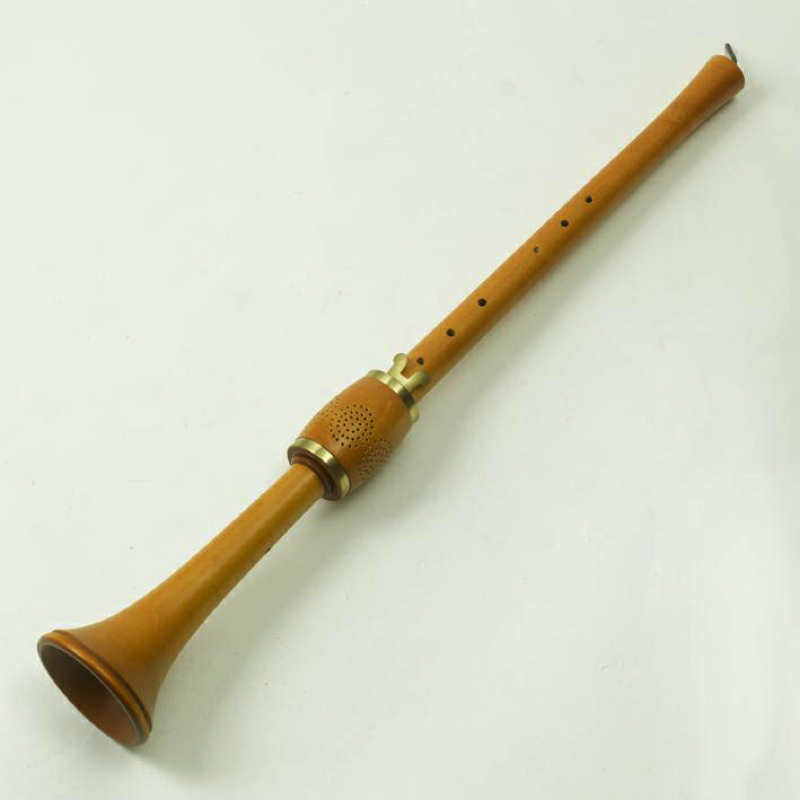Pommer
Woodwinds
Europe
Between 1001 and 1900 AD
Video
The pommer, also known as the bombard, is a historical double-reed woodwind instrument that has played a significant role in European music from the Middle Ages to the early Baroque period. Renowned for its powerful and resonant sound, the pommer is an ancestor of the modern oboe and has been integral to various musical traditions.
Description and Purpose
The pommer is characterized by its conical bore and typically made from wood, such as maple or fruit trees. It features a large double reed, which is crucial for sound production. The instrument is usually about 75 to 290 centimeters in length, depending on the specific type, and includes several finger holes and keys to facilitate playing. The pommer serves multiple purposes in musical contexts; it is primarily used for providing a strong melodic voice within ensembles, particularly during ceremonial occasions and outdoor performances. Its robust sound made it ideal for playing alongside other instruments, such as drums and brass, during festivities and military events.
History and Origin
The pommer has its origins in medieval Europe, evolving from earlier instruments like the shawm. The term “pommer” is believed to have derived from German artillery terminology, reflecting its powerful tone. Historical records indicate that the pommer became popular across Europe from the 14th century onward, particularly in Germany and France. Notably, Michael Praetorius documented various sizes of pommers in his work Syntagma Musicum, identifying seven distinct types ranging from sopranino to contrabass. This diversity allowed the pommer to adapt to different musical roles and contexts throughout its history.
Working Mechanism
Sound production in the pommer involves air being blown into the mouthpiece, causing the double reed to vibrate and produce sound. Players can manipulate pitch by covering or uncovering finger holes along the body of the instrument. The design typically includes five open finger holes and several keys that facilitate playing a wider range of notes. This construction allows for intricate melodies and harmonies, making the pommer a versatile instrument in ensemble settings.
Types of Pommer
There are several types of pommers based on size and pitch.
The alto pommer produces higher notes, while the bass pommer offers deeper tones.
The contrabass pommer, which can be quite large—sometimes reaching lengths of up to nine feet—provides an even lower pitch, enriching the harmonic texture of musical compositions. Each type serves specific roles within ensembles, allowing for a rich tapestry of sound.
Features
The pommer is distinguished by its conical bore design that enhances its warm sound quality. The instrument’s robust construction allows it to withstand outdoor performances while maintaining intonation and tonal integrity. Additionally, the pommer’s ability to blend well with other instruments makes it a valuable addition to both folk music traditions and classical ensembles.
It is a significant instrument in early music traditions, bridging historical practices with modern interpretations. Its unique sound and versatility continue to captivate musicians and audiences alike, ensuring its place in contemporary performances of Renaissance and Baroque music.
FAQ
What is the Pommer and its Historical Context?
The Pommer, also known as the bombard, is a double-reed woodwind instrument that was popular in Europe from the Middle Ages to the early Baroque period. It is characterized by its loud and powerful sound, making it suitable for outdoor performances and military music. The Pommer is considered an ancestor of the modern oboe and was used in various musical contexts, including court and ceremonial music.
How is the Pommer Constructed?
The Pommer is typically made from woods such as maple or fruit trees and features a conical bore with a goblet-shaped bell at the end. It consists of two main parts: the body and the reed. The instrument has multiple finger holes and keys that facilitate playing across its range, which can vary depending on its size, with some Pommers reaching lengths of up to three meters.
What Types of Pommers Exist?
There are several sizes of Pommers, including sopranino, soprano, alto, tenor, bass, and contrabass. Each type produces a different pitch range, with the contrabass being particularly large and capable of producing deep tones. Historical records indicate that there were as many as seven sizes of Pommers, allowing for a diverse range of musical expressions within ensembles.
What Role Does the Pommer Play in Modern Music?
Today, the Pommer is primarily used in historical performance ensembles that focus on early music. While it has largely been replaced by more refined instruments like the oboe in contemporary orchestras, it remains an important instrument for folk music in some regions of Europe, particularly in France and Spain. Its unique sound continues to be appreciated for its historical significance and distinctive tonal qualities.
 Links
Links
References
Other Instrument
Categories


















